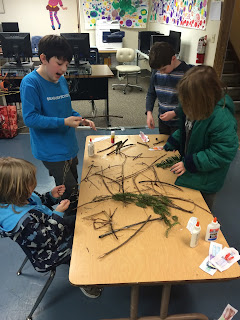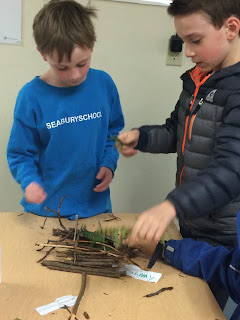We have looked at all kinds of art and artists this year, ranging from famous early American portrait artist Gilbert Stuart to pop art icons like Jim Dine. All along the way we have learned about different art mediums (the Pioneers are particularly good at watercolor painting), and we made everything from weavings and mobiles to Navajo style rug designs. Each and every student created some beautiful art works, with their unique and individual personal flair shining through! Everyone enjoyed seeing their work on display, art gallery style, at Seabury's first annual Art Show. I am so proud of these accomplished young artists!
Saturday, April 30, 2016
Auction Project
A little teaser for tonight's auction --
Each student made a print of a Tacoma area landmark or icon, which will all be framed together in a one-of-a kind artwork. Pictured above is the Narrows Bridge. I can't wait to see the final product tonight!
Thank you, Kirsty, for all your hard work on this -- and to the other parents who coordinated and researched ideas for our project - we couldn't do it without you!
Each student made a print of a Tacoma area landmark or icon, which will all be framed together in a one-of-a kind artwork. Pictured above is the Narrows Bridge. I can't wait to see the final product tonight!
Thank you, Kirsty, for all your hard work on this -- and to the other parents who coordinated and researched ideas for our project - we couldn't do it without you!
Sunday, April 24, 2016
Westward Ho - Engineering Challenges
As we imagined life on the trail and faced decisions day after day, we also struggled with some of the engineering challenges people might have faced. We started with making a wagon that would hold the most weight, then tried making a raft that would float a small wagon model, making a barrel that would hold water, and building a temporary shelter that would protect our wagon group. In each challenge, students were presented with materials and a few parameters, but no instructions. They worked together to come up with ideas, discussed ideas, tried things, got frustrated, and, yes - even argued. Sometimes, when no one was making any progress, we had to come together to see what one group was doing that might lead to a solution, while other times, all groups made a plan and forged ahead with no hesitation.
WAGON CHALLENGE:
Using the materials provided, can you build a wagon model to hold the most weight?
This group won the challenge by doubling up the cardboard wheels. This reinforcement made their wagon able to hold much more of a load than the wagons with single wheels, which folded under the weight of a few water bottles.
RAFT CHALLENGE:
Using the materials provided, can you build a raft that will float a small wagon model?
The winners - this raft floated for more than 15 minutes before the glue started to come apart.
After we had several effective rafts, we tried adding weight to see which one was the most buoyant.
BARREL CHALLENGE:
Using only the materials provided, can you build a barrel that will hold water?
We learned a lot through these challenges: mostly how to communicate ideas effectively, cooperate, collaborate, and work as a team; but also what types of shapes are strongest and how important craftsmanship can be (one of our water barrels that held water the longest did not use the plastic square -- the maker had glued the popsicle sticks so closely together that the water did not leak - just like a real Cooper would have done).
We hypothesized about what might work, tried, failed... and tried again. We discussed each other's designs, talking about what worked and what problems groups overcame and how they overcame them. Then we reflected on what worked and what did not in our own group's design. This is always a valuable process, no matter what the outcome! The outcome here, though - a whole lot of learning and a whole lot of fun.
WAGON CHALLENGE:
Using the materials provided, can you build a wagon model to hold the most weight?
This group won the challenge by doubling up the cardboard wheels. This reinforcement made their wagon able to hold much more of a load than the wagons with single wheels, which folded under the weight of a few water bottles.
RAFT CHALLENGE:
Using the materials provided, can you build a raft that will float a small wagon model?
The winners - this raft floated for more than 15 minutes before the glue started to come apart.
After we had several effective rafts, we tried adding weight to see which one was the most buoyant.
TEMPORARY SHELTER CHALLENGE:
Using only the natural materials provided, can you build a temporary shelter to hold your pioneer paper dolls?
The groups with Y-shaped sticks or sticks that naturally formed tripods had an advantage at the start.
Other groups soon realized they could create a Y-shape by splitting their sticks.
Some just tried a cone or tipi-type design.
Did starting with a base provide any advantage?
BARREL CHALLENGE:
Using only the materials provided, can you build a barrel that will hold water?
We learned a lot through these challenges: mostly how to communicate ideas effectively, cooperate, collaborate, and work as a team; but also what types of shapes are strongest and how important craftsmanship can be (one of our water barrels that held water the longest did not use the plastic square -- the maker had glued the popsicle sticks so closely together that the water did not leak - just like a real Cooper would have done).
We hypothesized about what might work, tried, failed... and tried again. We discussed each other's designs, talking about what worked and what problems groups overcame and how they overcame them. Then we reflected on what worked and what did not in our own group's design. This is always a valuable process, no matter what the outcome! The outcome here, though - a whole lot of learning and a whole lot of fun.
Subscribe to:
Posts (Atom)















































